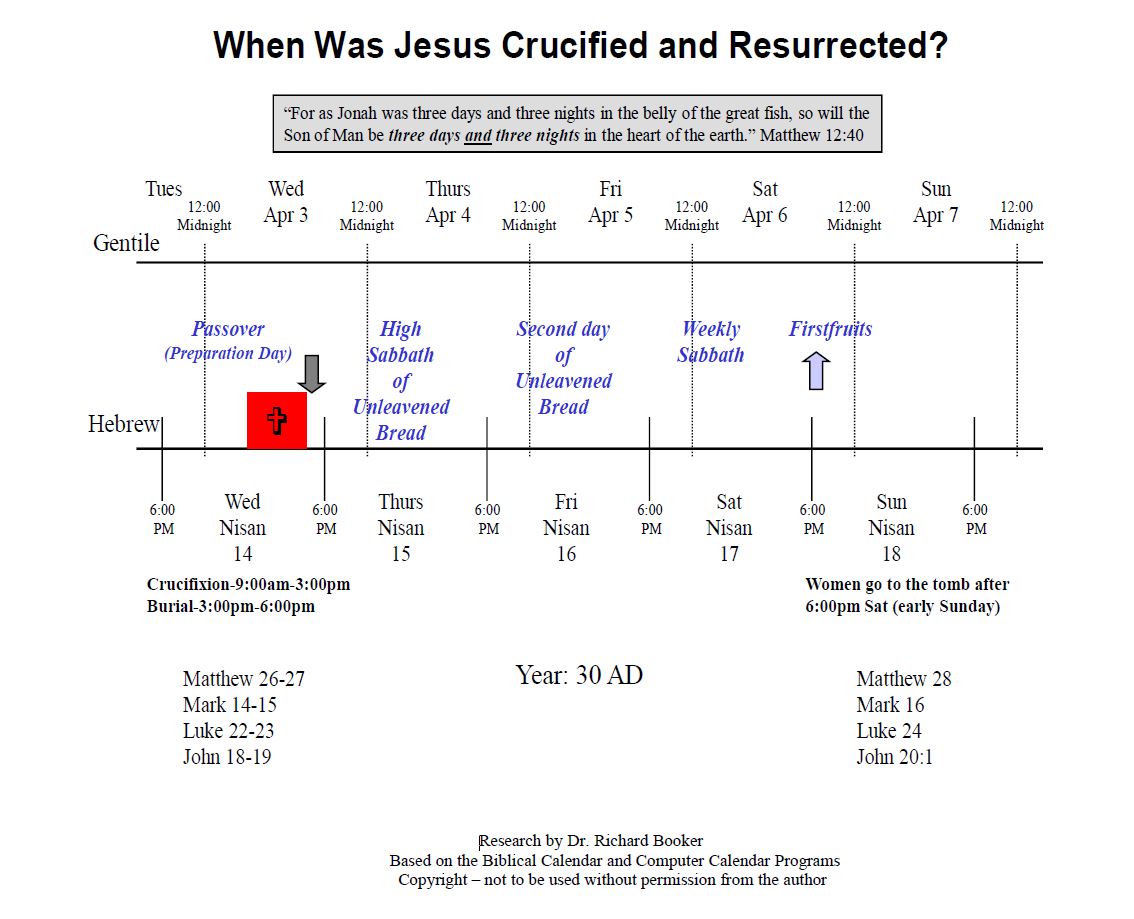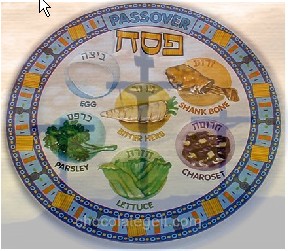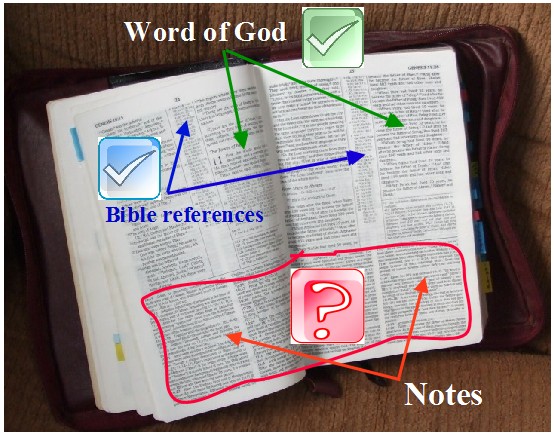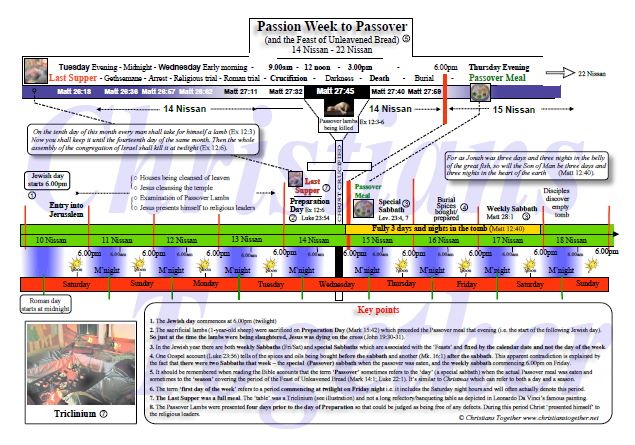 Related Articles
Related Articles
|
|
|
 Websites
Websites
|
|
|
 Files
Files
|
|
|
|
|
Easter; myths and traditions obscure amazing truths
The Passover Meal (Seder) embodies many spiritual truths concerning God's plan of redemption through Jesus Christ. However traditional church teaching (crucified Friday: resurrected Sunday) cannot be supported from a careful study of the Bible; and obscures the immaculate chain of events during the last week of Christ's life.
first published 11/04/2009
UPDATE: 28 March, 2024
The following article has been prefaced by:
 1. A recording of and discussion with Dr. Richard Booker on the subject of Passion Week and the chronology of Christ's crucifixion 1. A recording of and discussion with Dr. Richard Booker on the subject of Passion Week and the chronology of Christ's crucifixion
2. A simplified chart of Richard's detailing his view (and that of the Editor) that Christ was crucified on a Wednesday, just as the sacrificial lambs were being killed for the forthcoming Passover High Holy Day of First Fruits. The article 'When Jesus ate the Passover Meal' explains how Jesus ate the Passover the evening before the Passover lambs were killed.
UPDATE: 16 April, 2025
A presentation entitled Passover and Passion given the week prior to Easter in 2025. Geoff Barnard spoke from his home in Israel to an online audience on the background, nature and timing of Christ’s crucifixion during the Feast of Passover.
Sorry, your browser is unable to play this type of file.
You can still download it
Notes:
1. The above presentation minus the discussion session at the end can be found on YouTube here.
2. Be sure to scroll down to read the whole article (as originally published).
3. There are differing opinions regarding which day of the week Christ was crucified i.e. Wednesday, Thursday or Friday. Please see here for all charts outlining these views.
----------------------------------------
Talk and QnA session with Dr. Richard Booker.
Sorry, your browser is unable to play this type of file.
You can still download it
NOTE: Dr. Booker has written a number of books and it is recommended to visit his website for all information. One of the recommended books is entitled: 'Celebrating Jesus in the Biblical Feasts'.
---------------------------------------------------------
Original Article (04/2009)
 THIS PASSOVER (Pesach) Jewish families will gather around a festive table for the Seder (telling of the story and meal). The story of the Passover will be told from the Haggadah (a Jewish religious text), explaining the story of Moses and the Exodus. And how the Jewish people were in slavery in Egypt. THIS PASSOVER (Pesach) Jewish families will gather around a festive table for the Seder (telling of the story and meal). The story of the Passover will be told from the Haggadah (a Jewish religious text), explaining the story of Moses and the Exodus. And how the Jewish people were in slavery in Egypt.
Accounts are given of Moses confronting Pharaoh and the 10 plagues; how the first-born was spared by the blood of the lamb, and how God parted the Red Sea and delivered the Jewish people from slavery and bondage in Egypt.
A veil over their eyes
However most of the Jewish people living in Israel, the USA and other countries around the world, do not know (or do not understand, or will not accept) that Jesus’ blood was shed on Passover 2000 years ago, delivering them from spiritual bondage and giving them eternal life. And the rabbis forbid the reading of Isaiah Chapter 53 which speaks of Jesus as the suffering servant. (cf John 12:40)
Passover is revealed in many Messianic prophecies, but what is so wonderful is how God's fulfillment of prophecy is so perfect down to the hour! [Interestingly it is said that for religious Jews ‘coincidence’ is not a ‘kosher’ word.]
Easter
And while Gentile Christians rightly focus on the price paid at Calvary and the joy of the subsequent ressurection, there is - in traditional teaching - an anomaly which effectively obscures the full wonder relating to the amazing symmetry of all the events which took place over that momentous Passover season.
A lamb without blemish
Part of the biblical Passover practice was that the lamb, which would be used for the Passover, was to be set aside on the 10th day of the month of Nissan (Ex 12:3). It was then to be tested until the 14th day (Ex 12:6) to be certain it was without spot or blemish before it was killed. [It is interesting to note that part of the ‘testing’ process applied to the sacrificial lambs involved them being whipped lightly on their backs so the white wool became stained with blood - compare this with Jesus’ scourging.]
Jesus as the Passover Lamb was also set aside on the 10th day of Nissan, because it was on this day that He entered Jerusalem, fulfilling the prophecy in Zechariah 9:9. The true significance of His triumphal entry is that this was the occasion Jesus set Himself aside as the Passover Lamb. Jesus was tested from the 10th day until the 14th day of Nissan by the Pharisees, the Sadducees, the Scribes, and the Herodians. By answering all of their objections and questions, Jesus (the Lamb of God) clearly showed that He was without spot and without blemish. (See Footnotes)
Prophecy fulfilled
He was later crucified at nine o'clock in the morning and at the same time as the special Passover animals (lambs or he-goats) were being killed as a sacrifice on the Temple compound.
Just as the Jewish leaders were very careful that not a single bone of the Passover lamb was broken, John 19:36 points out that not a single bone of Jesus was broken either, during His scourging, the crucifixion itself, nor by the Roman soldiers who always broke the victim's legs.
But this year 14 million Jewish people worldwide will celebrate Passover in their homes with family and friends who are gathered around the table for the Seder meal, retelling the story of Passover without the revelation of its ultimate significance. As one Jewish believer (in Yeshua) has written:
‘No one has a clue as they read about God's deliverance in Egypt that the Passover lamb has been fulfilled in Jesus! Even though the Jewish people are known as the "People of the Book," most know little, if anything, about the Messianic prophecies. The rabbis do not investigate or discuss the Messianic prophecies, and they ignore what Moses says: "without the blood atonement, there is no redemption of sin."’ (Lev. 17:11)
What began at the first Passover was later fulfilled by Jesus, once and for all! Moses stood up to Pharoah saying: ‘Let my people go!’ so that the Jewish people would be freed from bondage and they could worship God in freedom.
Today Moses is not here, but the Gentile church is required by God to reach out to the Jewish people so that they can be delivered from eternal death and set free by knowing Jesus the Passover Lamb, who gives freedom and eternal life. And one day the scales will be removed from the Jewish eyes and ‘they will look on Me whom they have pierced; and mourn for Him as an only son’ (Zech 12:10).
Pilgrim Feasts: two fulfilled, one to go
Of all the Jewish feasts detailed in the Bible, Passover was/is the first of the ‘Pilgrim Feasts’ during which the Jews ‘went up’ to Jerusalem to celebrate. (Leviticus 23) Accordingly two of these feasts (Passover and Pentecost) have now found their fullest expression in the outworking of God’s purposes. The Feast of Passover (Ex 12:43; 13:10) was enacted supremely by Jesus’ death on the cross. The Feast of Weeks (50 days after Passover; Deut 16:9-12) saw the Holy Spirit come down at Pentecost.
Tabernacles awaits its greatest hour
But the third of these feasts, The Feast of Tabernacles, yet awaits its greatest expression. Following the opening of the Jewish eyes, the prophet Zechariah goes on to describe momentous events.
‘On that day a fountain will be opened to the house of David and the inhabitants of Jerusalem, to cleanse them from sin and impurity.’ (Zech 13:1) ‘...on that day his feet will stand on the Mount of Olives, east of Jerusalem’. (Zech 14:4)
It will be a time of a great blessing upon the whole world. Paul wrote to the church in Rome: ‘But if their transgression means riches for the world, and their loss means riches for the Gentiles, how much greater riches will their fullness bring!’ (Rom 11:12) and continued by emphasising: ‘For if their rejection is the reconciliation of the world, what will their acceptance be but life from the dead?’ (Rom 11:15). ‘
Glory in the whole earth
The prophet has foretold: ‘The Lord will be king over the whole earth. On that day there will be one Lord, and his name the only name.’ (Zech 14:9)
Though preceded by a time of much tribulation, ‘the survivors from all the nations that have attacked Jerusalem will go up year after year to worship the King, the LORD Almighty, and to celebrate the Feast of Tabernacles.’ (Zech 14:16)
At Passover (the word 'Easter' doesn't appear in the original Bible texts; Note 4.) as we remember the Lord’s death and celebrate his resurrection, we do so ‘until He comes’. (1 Cor. 11:26)
He is Risen. Hallelujah!
Amen. Come Lord Jesus!
----------------------
'Easter' myths obscure the true wonder of it all
For as Jonah was three days and three nights in the belly of a huge fish, so the Son of Man will be three days and three nights in the heart of the earth. Matthew 12:40
Jesus was crucified on Wednesday, not Friday
 Church tradition teaches that Jesus was crucified on Friday and rose again early on Sunday morning. Church tradition teaches that Jesus was crucified on Friday and rose again early on Sunday morning.
This contradicts the passages which tell us that Jesus would be 3 days and 3 nights in the grave (e.g. Matt 12:40; 26:61; 27:63). And suggesting (in this case) that 'a part of day is equal to a whole day' does violence to the word of God.
In fact Jesus was crucified earlier in the week; and he would have been dying on Calvary’s cross on ‘preparation day’ (Luke 23:54) at precisely the same time as the High Priest priests would have been sacrificing the passover lambs for the nation in the temple precincts.
This satisfied the Jewish leaders' desire to avoid having Jesus killed 'during the Feast' (Matt. 26:5).
The High Priest concluded the 2-day slaughter of the sacrifices at 3.00pm on 14 Nisan with the cry: "It is finished" (cf John 19:30). What a wonder of God's precision and of that amazing symmetry.
Jesus was then buried before the annual (Passover) sabbath (John 19:31) – the day of Passover which commenced at 6.00pm on that same day. He then rose three days later, after the weekly sabbath (Mark 16:9), fulfilling the typology of Jonah to which Jesus had referred (see later notes).
Click on image below for chart showing events of Passion Week

The Firstfruit(s) of our Salvation
Since Jesus was crucified on Preparation Day (John 19:31 et al) – on 14 Nisan according to the Essene calender; the day before the main Passover – and was resurrected three days and nights after He was crucified, Jesus arose from the grave on the seventeenth of Nisan, a day of the festival of First Fruits. In fact, Jesus is called the first fruits of those who rise from the dead.
But now is Christ risen from the dead, and become the firstfruits of them that slept. For since by man came death, by man came also the resurrection of the dead. For as in Adam all die, even so in Christ shall all be made alive. But every man in his own order: Christ the firstfruits; afterward they that are Christ's at his coming (1 Corinthians 15:20-23).
The keys to understanding the (Passover) timeline of Jesus' last week lie in the knowledge that –
(a) The Jewish 'day' ran from twilight on one day until twilight the next. For the Jews the evening that Jesus died was actually a new day.
(b) Passover was both a 'day' and a 'week'
The term ‘Passover’ was applied both to a single day and also to a 'period of days'; in much the same way as we talk about Christmas as being a ‘day’ but also a ‘season’. The Passover day (commencing at sunset on 14 Nisan) was at the commencement of the seven-day Festival (Feast) of Unleavened Bread (15 - 21 Nisan: Lev 23:6; Num 28:17) and 'Passover' became the name for the entire festival. (Luke 22:1).
(c) The Passover lambs had to be tethered for five days before they were killed so that they could be carefully examined for any blemishes, and to allow that period of time to elapse so that any hidden defects would become apparent. If indeed Jesus was crucified in the middle of the week, this four-day period, when he was being 'examined' by the religious leaders, would exactly coincide with the time during which the sacrificial lambs were undergoing scrutiny (Exod. 12:3-6).
(d) There are both weekly and annual sabbaths in Old Testament (Jewish) law
In addition to the weekly Sabbaths (which always fell on a Friday/Saturday) there were also yearly Sabbaths (High Holy Days) which fell on a specific date during a specific month e.g. Passover (day) was/is an annual ‘sabbath’ (John 19:31) and always falls on 14 Nisan (Lev. 23:5-7) – irrespective of what day of the week that is in any one year. So (for instance) at one of the Feasts there would regularly have been two sabbaths within a seven-day period.
This reconciles the apparent contradiction in the Gospels whereby Luke’s account describes the two Marys and Salome preparing the burial spices and perfumes before the Sabbath (Luke 23:56), while Mark’s gospel places this activity after the Sabbath(s) (Mark 16:1 and Note 1.) i.e. the ladies did their preparation work after the (annual) Passover Sabbath (14 Nisan) but before the weekly Sabbath (Friday 6.00pm - Saturday 6.00pm) and in advance of them going to the tomb early on Sunday morning only to find that Jesus had already been resurrected.
Note 1.
In Mark 16:1 the Greek word for 'sabbath' can be used in the plural i.e. the text could read: 'When the Sabbaths (plural) were over...'
Note 2.
The Study Bible version of a highly-respected and most popular modern translation comments - with charts and illustrations - on its chronology of Passion Week, and in its attempts to reconcile its interpretation states: "The Scriptures do not mention this (Wednes)day, but the counting of the days seems to indicate that there was another day concerning which the Gospels record nothing." '[Emphasis added]
So if we are to believe that comment and interpretation, during the most astounding seven days of human history and with four apostles recording the events under the inspiration of the Holy Spirit there was/is one 'missing' day during which nothing of any consequence happened!
See Study Bibles: danger, handle with care!
Note 3. Going by the Essene calendar, the Last Supper was eaten on the night before Passover. It was a full meal and Jesus was - figuratively speaking - the sacrificial lamb at the table.
Note 4.
Easter (Nelson's Illustrated Bible Dictionary)
A feast or festival of the Christian church that commemorates the resurrection of Christ. It is observed and celebrated on the first Sunday following the full moon that occurs on or after March 21--or one week later if the full moon falls on Sunday. In other words, Easter falls between March 22 and April 25.
Easter was originally a pagan festival honoring Eostre, a Teutonic (Germanic) goddess of light and spring. At the time of the vernal equinox (the day in the spring when the sun crosses the equator and day and night are of equal length), sacrifices were offered in her honor. As early as the eighth century, the name was used to designate the annual Christian celebration of the resurrection of Christ.
The only appearance of the word Easter (KJV) is a mis-translation of 'pascha', the ordinary Greek word for 'Passover' <Acts 12:4>.
 Note 5. See also related article: 'Passion Week/Last Supper/Traditions' which includes a recorded interview with Chris Hill. Note 5. See also related article: 'Passion Week/Last Supper/Traditions' which includes a recorded interview with Chris Hill.
Additionally 'Remembering His deth; the snack we call Supper'.
|
Christians Together, 27/03/2024
|
(page
1
2)
| |
|
Leo Rose (Guest) |
12/04/2009 16:13 |
Paul's commentary about why Moses veiled his face:
Unlike Moses, who put a veil over his face so that the children of Israel could not look steadily at the end of what was passing away. But their minds were blinded. For until this day the same veil remains unlifted in the reading of the Old Testament, because the veil is taken away in Christ. But even to this day, when Moses is read, a veil lies on their heart.
Nevertheless when one turns to the Lord, the veil is taken away. 2 Corinthians 3:13-16
Because of this veil, the majority of Jews do not see Y'shua Jesus in the writings of Moses - Torah.
|
| |
|
Paul C (Guest) |
13/04/2009 11:06 |
an amazing bit of clear teaching with the refs., which resolved issues and opinions I had heard for years without clarity….
Thx so much!
|
| |
|
Bonita R (Guest) |
13/09/2013 16:24 |
Hello, I stumbled onto your website tonight in an effort to find the best timeline chart of the Week of Christs crucifixion.
Yours seems to be the one as I believe from studying over 4 years on the subject that he was indeed crucified on Wednesday. Do you sell copies of this chart to the public? How can I get one.
Thank you for your time. And for a great and well-done website.
|
| |
|
Editor |
13/09/2013 17:47 |
Bonita, thank you for your comments and encouragements. If you have additional insights I would be very interested to know of them.
Meanwhile you can download the PDF version of the timeline chart by clicking on the image of the chart in the article.
|
| |
|
Editor |
04/04/2021 11:23 |
From Ian:
>>>>
Thank you so much for this. The information in the attached chart is a great summary, and the linked article it is taken from is the best explanation of the events that took place over what we know as Easter that I have ever read. It just makes everything fall into place and fit together perfectly. None of the various explanations and theories trying to make all the Scriptures and events fit, that I have heard over the years, have ever satisfactorily done this for me before.
I was wondering if I may have your permission to share the article and chart with the small congregation at our church? I would be most grateful if this is possible.
<<<<
To Ian: Feel free to copy the article and the chart to anyone who might who might find it of interest.
|
| |
|
Editor |
05/05/2022 10:56 |
The author of a book on the subject of the chronology of the Crucifixion has Christ being sacrificed on Thursday whereas the chart I have produced shows Wednesday. It was so long ago I can't remember the nature of his objection(s) to my view, but I would encourage everyone to 'Be a Berean'.
|
| |
|
Jenny Yates |
05/05/2022 11:36 |
I agree Jesus did not die on a Friday. However, I think Thursday is far more likely than Wednesday, for the following reasons:
- If Wednesday was 14th Nisan, then 10th Nisan, the day of the triumphal entry, would have been the previous Saturday, the Sabbath. Bethany and Bethphage were more than a Sabbath Day's journey from Jerusalem, so Jesus, his disciples and fellow pilgrims from Galilee would not travelled that far - and the donkey shouldn't have been working on the Sabbath! (Ex.20:10).
- If Jesus died on a Wednesday, and the special Sabbath/Holy Day for Unleavened Bread was Thursday, why did the women wait until Sunday morning to go to the tomb to complete the embalming process? Surely, they would have gone on the Friday, an ordinary working day. Obviously daybreak on Sunday was the earliest possible moment they could have gone without breaking the law. Therefore, the two Sabbaths were consecutive.
I have no problem with accepting a part of Thursday as one day, in accordance with the Hebraic way of reckoning; add Friday and Saturday = three days. Thursday, Friday and Saturday nights = three nights. Jesus rose sometime during Saturday night. Besides references to 'three days and three nights', there are also several references to Jesus rising 'on the third day'. If he died on a Wednesday, Sunday would be the fourth day.
I strongly recommend the book 'Three Days and Three Nights that changed the World, by David Serle and Peter Sammons, who make an excellent case for a Thursday crucifixion.
A couple of corrections:
1)Passover is the first pilgrim feast, not the second.
2) Jesus did not die in the evening; he died in the afternoon. According to Luke 23:44-46, it was just after 3pm (the ninth hour). He was buried before sundown, the start of the new day.
3)The soldiers did not routinely break the legs of crucified victims. They broke the legs of the two thieves in order to hasten their deaths and get them off the crosses before sundown. With legs broken, a victim could no longer push himself up to keep breathing, so quickly died of asphyxiation.
|
| |
|
Editor |
05/05/2022 19:57 |
Thanks Jenny for spotting that error. You're right: Passover was/is the first Pilgrim Feast. I've made the correction.
However regarding the time Jesus spent in the tomb the Bible says:
Jonah 1:17
17 And the LORD appointed a great fish to swallow Jonah, and Jonah was in the stomach of the fish three days and three nights.
Matthew 12:39-40
39 He answered, "A wicked and adulterous generation asks for a miraculous sign! But none will be given it except the sign of the prophet Jonah.
40 For as Jonah was three days and three nights in the belly of a huge fish, so the Son of Man will be three days and three nights in the heart of the earth.
Regarding the separation between the Sabbaths Luke 23:56 sees the spices and oils being bought "before the Sabbath" and Mk. 16:1 "after the Sabbath. So how could these (two different) Sabbaths have been contiguous?
|
| |
|
Jenny Yates |
10/05/2022 11:37 |
Hi Colin: Sorry, but I think your argument based on a comparison of Luke 23:56 and Mark 16:1 is very weak. There are much simpler, possible explanations as to why Luke says the women prepared the spices and ointments BEFORE resting on the Sabbath, and Mark says they bought them AFTER the Sabbath, none of which requires an ordinary day between the special Sabbath and the regular weekly Sabbath.
1) The women began to prepare the spices late on Thursday afternoon, but didn't have enough, so they bought more once the Sabbaths ended at sundown on Saturday.
2) The women were almost certainly from different households. Before going home after the burial, they arranged to meet on Sunday morning to complete the embalming process. Those who already had a supply of spices in the house prepared them before sundown on Thursday: Luke got his account from them. Those who hadn't, bought some once the Sabbaths ended: Mark got his account from them (? via Peter)
.
3) This is simply one of those trivial differences between the resurrection accounts, which are good evidence they were written by eye-witnesses, or by people close to eye-witnesses (as per point 2 above). They were not made up two or three centuries later! There are other minor differences in these accounts, such as the number of women who went to the tomb; the number of angels they saw etc.
As for the 'three days and three nights', the same explanation - that in Hebraic thinking, part of a day counts as one day – can apply to both Jonah in the fish and Jesus in the tomb. You surely don't believe Jonah was in the fish for exactly 72 hours?!
For the reasons given previously, I still maintain that the crucifixion was almost certainly on a Thursday: a) The triumphal entry could not have been on the Sabbath, because Bethphage was more than a Sabbath-day’s journey from Jerusalem; the donkey shouldn’t have been working, and nor should the money-changers in the temple! b) The women would not have waited until Sunday to go to the tomb, they would have gone on Friday, if Friday had been an ordinary day. I suggest this evidence far outweighs any based on an apparent minor discrepancy about when they bought and prepared the spices.
|
(page
1
2)
|
|
|